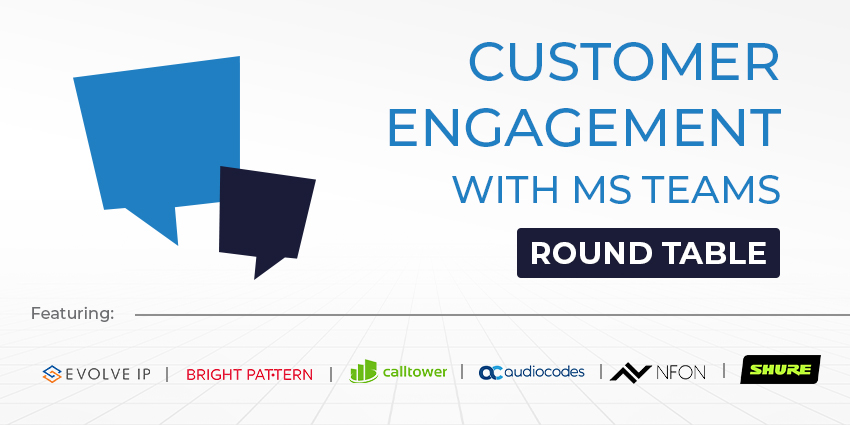As organisations increasingly rely on Teams for seamless communication, they’re exploring new ways to enhance customer engagement directly through the platform. Leveraging UC&C capabilities in Teams enables companies to provide real-time support, foster stronger relationships, and streamline interactions, making every touchpoint more meaningful.
With our latest Round Table subject, “Customer Engagement With MS Teams”, we spoke with experts and executives from Evolve IP, AudioCodes, Bright Pattern, Midwich and Shure, NFON, and CallTower about the trends around how customers are adopting Microsoft Teams for collaboration and client engagement, the common challenges around customer engagement in Teams, how businesses can ensure secure and compliant Teams interactions, and what the future of customer engagement in Teams might look like.
What trends have you observed in how customers are adopting Microsoft Teams for collaboration, and how are they using it to enhance engagement with clients?

Scott Rixon, Solutions Director at Evolve IP
Rixon observed that the response the working world had to the pandemic paved the way for how people collaborate forever.
“Hybrid work and video calls are now a natural and expected daily occurrence for many organisations, with Microsoft Teams becoming the de facto standard,” Rixon said. “People often say, ‘Let’s jump on a Teams call’ as well as other providers such as Webex being another popular alternative.”
Rixon added that face-to-face meetings still have a lot of value, but video collaboration is now a proven alternative that saves businesses time and money.
“Organisations can greatly improve their customer experience and provide their workforce with more flexibility about where, when and how they work,” he continued.

Gidi Adlersberg, Voca CIC Business Line Manager at AudioCodes
Adlersberg noted that throughout 2024, AudioCodes continues to see enterprises utilise their investment in Teams for CX. “With the consumer push for better service, more companies see the immense value of Teams as a consolidated communications platform that caters to both UC and contact centre needs,” he said.
“We’re seeing a strong desire from customers who need a connection between the contact centre agent and the back-office knowledge expert. This is where Microsoft Teams, as the base for an organisation’s contact centre, really shines.”
Adlersberg also highlighted that Teams for collaboration gets even better with the “new and exciting opportunity” of bringing CX capabilities like skill-based routing, queueing, and reporting to departments beyond the traditional contact centre, such as the IT Helpdesk, Travel desk, Security team, and Sales department.
“As the Teams ecosystem continues to grow, with its strong emphasis on Teams Phone, we expect to see more enterprises harnessing Teams as a one-app, one-screen experience for service professionals across the organisation,” Adlersberg said.
Tyler Troutman, Strategic Market Development at Shure
For Troutman, organisations are increasingly adopting Microsoft Teams for seamless collaboration, integrating it with other Microsoft services like SharePoint to ensure secure data sharing and compliance.
“This integration helps in maintaining security and compliance while enhancing client engagement,” Troutman said. “For example, companies are using Teams to facilitate effortless document sharing and communication within a secure environment, which is particularly beneficial in highly regulated industries.”
Michael McCloskey, CEO at Bright Pattern
McCloskey emphasised the tremendous evolution of Microsoft Teams.
“MS Teams integration has proven crucial as we see it as one of the most important integration points for our customers,” McCloskey affirmed. “Teams experienced many challenges when it was initially released, but has now transformed the way that businesses communicate. From meetings to chats to integrations to MS applications like Dynamics and MS AI, they are a major force.”
William Rubio, Chief Revenue Officer at CallTower
Rudio, too, underlined that the adoption of Microsoft Teams has soared, with millions of users worldwide relying on its robust platform for seamless communication.
“This surge is largely driven by the integration of options like Operator Connect, which empowers administrators to seamlessly connect calling services while managing voice networks and infrastructure,” Rubio stated. “The result is a powerful, efficient communication platform that enhances engagement with clients and streamlines operations. Moreover, Microsoft Copilot is revolutionising productivity by providing users with intelligent insights and automation capabilities.”
Rubio added that these advancements empower businesses to harness creativity and efficiency across various Microsoft applications, “further cementing Teams’ status as an indispensable collaboration tool”.
Myles Leach, Managing Director at NFON UK
Leach highlights that companies are increasingly adopting Microsoft Teams as a unified platform for communication, covering messaging, video, file sharing, and task management.
“By centralising these channels, Teams enhances both internal collaboration and client interactions. Integration with CRM, ERP, and productivity tools, like Dynamics 365 and Salesforce, brings essential client data directly into conversations, enabling more productive interactions,” Leach said.
Leach stressed that Teams supports client onboarding and training through live or recorded sessions and dedicated channels for ongoing support, creating a seamless and documented client journey.
“Automated workflows and bots streamline routine tasks such as follow-ups and scheduling, allowing sales teams to focus on high-impact engagements,” Leach continued. “AI features like meeting summaries and insights further personalise client interactions by tracking sentiment and action items.”
“By integrating voice solutions, companies can manage calls alongside other tools, providing a comprehensive engagement platform that deepens client relationships and improves retention.”
Louis Robinson, UC&C Sales Specialist at Midwich and Shure Customer
Robinson highlighted four key trends, including growing interest in AI and productivity tools.
“Increasingly, customers are asking about Copilot and other AI tools that can drive productivity, streamline workflows, and enhance collaboration within Teams,” Robinson said.
Another was a preference for speaker tracking and framing options. “Speaker tracking is frequently requested in initial designs,” Robinson said. “However, after experiencing individual framing during demos, customers often prefer this setup over single-camera solutions or explore more specialised tracking setups for enhanced engagement.”
A third trend Robinson outlined is the expansion of small video-enabled spaces. “With Teams being such a widely used communication tool, more organisations are utilising smaller spaces for video conferencing, enabling more flexible and agile collaboration.”
One final trend is the demand for all-in-one portable devices. “There’s growing interest in portable, multifunctional devices that support video conferencing and whiteboarding, reflecting the shift towards flexible work environments,” Robinson added.
What are some common challenges organisations face when using Microsoft Teams to engage with customers, and how can these be mitigated?

Louis Robinson, UC&C Sales Specialist at Midwich and Shure Customer
Robinson outlined three common challenges, including the coordination between AV and IT teams. This “sometimes leads to licensing issues or mismanaged Teams setups,” Robinson said. “Increased cross-training for AV professionals on UC/IT principles could help bridge this gap and improve deployment success.”
Another challenge is end-user training gaps. “While Teams Rooms systems are marketed as user-friendly, a lack of hands-on training often leaves end-users struggling with basic functions,” Robinson explained. “Providing structured training and quick-start guides can enhance user confidence and reduce support requests.”
Robinson’s final challenge is selecting the right equipment for spaces. “A major recurring challenge is selecting AV equipment that matches the room’s design and acoustics, especially in spaces with glass or minimalistic designs,” Robinson articulated. “Educating stakeholders on the ROI of purpose-built conferencing solutions can help them invest in equipment that delivers consistent performance rather than opting for generic or quick-fix options.”

Myles Leach, Managing Director at NFON UK
Leach suggested several challenges, including managing external access, ensuring data security, organising workflows, and maintaining consistent engagement.
“External access for clients can pose security risks, but Teams’ guest access and permissions settings enable secure collaboration, with added protection from regular permission reviews and expiration dates,” Leach clarified. “Compliance with GDPR is also crucial; data governance policies, including data loss prevention (DLP) settings, encryption, and threat protection, help ensure compliance and data security.”
Leach added that Teams’ multiple channels can lead to disorganised interactions and missed follow-ups. “To combat this, organisations create structured channels or client workspaces to centralise communications, files, and tasks,” he said. “Project management tools like Planner and CRM integrations also aid in tracking client engagements. To ease clients into Teams, quick onboarding and tutorials improve accessibility.”
Leach affirmed that standardised processes like regular check-ins, follow-up reminders, and structured agendas make maintaining consistent engagement easier. “Automated workflows further streamline interactions, keeping them organised and client-focused,” he continued.
William Rubio, Chief Revenue Officer at CallTower
Rubio asserted that one of the most significant challenges organisations face is dealing with unexpected service outages.
“These disruptions can hinder business operations, delay responses, and ultimately affect customer satisfaction,” Rubio expanded. “In a world where instant communication has become the norm, even a minor outage can lead to major setbacks. CallTower addresses this growing concern with custom failover solutions to manage various outage scenarios and a powerful One Click Failover solution to manage widespread issues quickly.”
Tyler Troutman, Strategic Market Development at Shure
Troutman outlined that a common challenge is customers’ use of different platforms, which can create friction in communication.
“Microsoft Teams addresses this with features like ‘Join a Teams Call’, which allows customers to join meetings with a single click without needing a Teams license,” Troutman said. “This feature simplifies the process and reduces barriers to engagement, making it easier for organisations to interact with their clients regardless of the platform they use.”
Scott Rixon, Solutions Director at Evolve IP
Rixon noted that while Microsoft Teams has become a leading video conferencing powerhouse, there are still challenges in other areas of the collaboration mix.
“For example, VoIP telephony and its lack of maturity compared to a traditional PBX,” Rixon expounded. “As true experts in calling, Evolve IP recognises the importance of being able to provide carrier-grade audio as well as integrating many other features and functions that fill in the gaps of the native Teams ecosystem.”
“Being able to provide seamless international coverage and numbers is another growing area for our partners with our EMEA partner base working with international businesses.”
Gidi Adlersberg, Voca CIC Business Line Manager at AudioCodes
Adlersberg emphasised that some companies are still hesitant to rely on Teams for CX, especially when it comes to uptime considerations.
“We believe the stability and availability of the contact centre channels are the bread and butter of any CX operation, even before adopting AI or other customer enhancement capabilities,” Adlersberg added. “In simple words, before any fancy capability, the contact centre has to be up and running at all times. You’d be surprised to see how many companies leave uptime to the wayside.”
Adlersberg stressed that different Teams contact centre integrations present important considerations for customers to address and are key to deciding which Teams contact centre to select.
“AudioCodes Voca CIC is a native Azure-based application, the same as Teams,” he explained. “This means Voca CIC uses Teams Phone calling infrastructure to deliver the contact centre connection. With Voca CIC, calls begin, stay, and end in Teams to deliver superior uptime, reliability, and accuracy in real-time routing decisions.”
“Microsoft’s recent announcement of 99.999 percent uptime for Teams Phone reinforces our commitment to addressing customer concerns, making Teams and ACS a reliable foundation for exceptional CX.”
Michael McCloskey, CEO at Bright Pattern
McCloskey noted that while Teams offers a powerful platform for customer engagement, organisations inevitably encounter certain challenges.
“For example, MS Teams require reliable network connectivity to ensure a positive communication experience,” McCloskey said. “Integrations to other systems can sometimes be a challenge, as well as performance issues as interactions increase. By addressing these challenges and implementing effective strategies, organisations can leverage Microsoft Teams to enhance customer engagement, improve productivity, and drive business growth.”
How can businesses ensure secure and compliant customer interactions when using Teams, especially in highly regulated industries?

Michael McCloskey, CEO at Bright Pattern
McCloskey stressed a critical factor when using Teams with customers is data and information security.
“Users must be educated on data security and privacy to ensure that sensitive data is not disclosed,” McCloskey expanded. “This is especially true in regulated environments. For instance, there are very stringent requirements with respect to healthcare (HIPAA) as to the disclosure around personal or medical information. Proper training is imperative to make sure that information is not disclosed inappropriately.”

Tyler Troutman, Strategic Market Development at Shure
Troutman affirmed that selecting devices that incorporate security features is crucial for safeguarding secure and compliant customer interactions.
“Within their own network, businesses can ensure secure interactions by leveraging Shure’s audio encryption to protect against eavesdropping,” he said. “Shure provides 256-bit AES encryption between devices, ensuring that audio data is secure during capture and transmission.”
“Additionally, Microsoft Teams offers built-in encryption and compliance standards (e.g., ISO standards, HIPAA) for data security during transit and at rest. This combination ensures end-to-end security for customer interactions, from the physical audio capture to the data storage and transmission within Teams.”
Gidi Adlersberg, Voca CIC Business Line Manager at AudioCodes
Adlersberg highlighted that security and compliance have always been top priorities in enterprise IT, and with AI’s growing role in CX operations, securing CX is more essential than ever.
“In response, Microsoft has increased its focus on security, especially over the past year,” Adlersberg noted. “Satya Nadella highlighted this in his October 2024 annual letter, mentioning Microsoft’s ‘Secure Future Initiative,’ which underlays security at the heart of every Microsoft service.”
Adlersberg clarified that the Microsoft Teams Certified Partner Program requires each certified vendor to meet rigorous compliance, security, and data protection standards to ensure enterprise-grade reliability.
“For CX interactions, Voca CIC safeguards contact centre data and customer interactions, keeping them secure and compliant,” he said. “This is achieved through modern data retention practices and AudioCodes’ compliance recording SaaS solution, SmartTAP.”
Scott Rixon, Solutions Director at Evolve IP
Rixon underlined that secure and compliant Teams operations are vital, especially as regulations continue to evolve and diversify.
“MiFID II is one high-profile area where flexibility is important,” Rixon stated. “For example, we can offer five-to-seven-year terms around call capture. PCI Compliance also needs to be on a reseller’s radar following major changes announced earlier this year.
Rixon added that evidence-based processes now need to be in place regarding over-the-phone card payment processes. Rixon argued that PCI 4.0 has “changed the game”, where a business must prove it is fully compliant rather than just verbally indicating it is.
“Many businesses are still not aware of the changes,” he continued. “The ‘Pause and Resume’ model—where credit card details are not recorded when taking payments over the telephone—simply isn’t fit for purpose.”
Louis Robinson, UC&C Sales Specialist at Midwich and Shure Customer
Robinson cited four strategies for secure and effective compliance, including proper tenancy management. “Effective management of tenancy settings ensures secure interactions and aligns with regulatory requirements,” he said.
A second strategy is in-house security testing. “Pre-deployment security testing tailored to the organisation’s needs helps maintain compliance and safeguard data integrity.” Another suggestion is user-focused security walkthroughs. “New users can benefit from a security-focused orientation to Teams, ensuring they understand best practices for secure video conferencing,” Robinson said.
A final idea is dedicated AV/VC networks: “Designing dedicated AV or VC networks can prevent security risks associated with shared networks, especially in businesses with high network traffic from various departments.”
William Rubio, Chief Revenue Officer at CallTower
Rubio stressed that ensuring secure and compliant customer interactions is paramount in 2024.
“CallTower’s solutions are engineered from the ground up to meet stringent industry standards, including HIPAA, FEDRAMP, and CJIS compliance,” Rubio outlined. “By leveraging CallTower’s secure communication infrastructure, businesses can focus on delivering exceptional service without compromising on data security or compliance.”
Myles Leach, Managing Director at NFON UK
Leach suggested that businesses should utilise Teams’ security features and governance practices to secure and comply with regulations during customer interactions on Microsoft Teams, especially in regulated industries.
“Data loss prevention (DLP) policies help prevent the sharing of sensitive information by automatically flagging potential breaches, thus safeguarding client data and ensuring compliance. Multi-factor authentication (MFA) and encryption for communications further protect against unauthorised access and maintain data privacy.”
Leach argued that role-based permissions and managed guest access are essential; by granting only necessary permissions and regularly reviewing access, businesses can limit sensitive data exposure. He added that Microsoft’s compliance tools, like audit logs, retention policies, and e-discovery, support tracking and retrieval of communications to meet regulatory requirements.
“Employee training on Teams’ security protocols and data handling best practices strengthens compliance,” Leach said. “Together, these strategies enable businesses to confidently use Teams for secure, regulatory-compliant customer engagement.”
Where do you see the future of customer engagement with Microsoft Teams heading, and what emerging trends should businesses keep an eye on?

William Rubio, Chief Revenue Officer at CallTower
Rubio foretold that as our industry looks to the future, customer engagement with Microsoft Teams is poised for further transformation. He underscored that emerging trends such as AI-driven communication and global connectivity are set to redefine the collaboration landscape.
“CallTower is leading the charge by expanding its global Microsoft Teams solution, offering high-quality calling services across over 100 countries and 6000 cities,” Rubio said. “This global reach ensures that businesses can connect with clients anywhere, anytime.”
“To prepare for these changes, businesses should stay informed about the latest technological advancements and consider integrating AI-powered tools to enhance their communication strategies. By partnering with CallTower, organisations can leverage cutting-edge solutions that not only meet current needs but also anticipate future demands.”
Myles Leach, Managing Director at NFON UK
Leach suggested the future of customer engagement with Microsoft Teams is moving toward a more integrated, AI-driven experience that enhances personalisation and efficiency.
“UK businesses can look forward to advanced AI features for tracking customer sentiment, automating routine tasks, and delivering insights to elevate service quality,” he expanded.
Leach also outlined that deeper CRM and productivity tool integrations will enable real-time access to customer data during interactions, creating a seamless customer experience. The growth of virtual and hybrid meetings will also drive demand for more immersive communication formats, with real-time transcription, language translation, and enhanced collaboration spaces becoming standard.
“As regulatory requirements for data privacy increase, UK businesses should watch for updates in Teams’ compliance and data governance tools, ensuring secure and compliant customer relationships,” Leach continued. “By staying current with Teams’ AI advancements, improved integrations, and evolving compliance tools, UK businesses can maintain a competitive edge in customer engagement.”
Louis Robinson, UC&C Sales Specialist at Midwich and Shure Customer
Robinson suggested advancements in AI-driven collaboration as a key trend. “With the evolution of AI, tools like Copilot will likely become integral to maximising meeting productivity,” Robinson said. “Companies should prioritise training employees on AI tools as part of the onboarding process to boost efficiency.”
A second future trend is the impact on education and learning spaces. “Teams could facilitate remote learning, offering institutions the ability to onboard more students and support global education initiatives, ultimately driving sustainability and accessibility in learning,” he explained.
A final trend is accessibility enhancements because “accessibility is a growing focus, with features like hearing loops, adjustable screen mounts, and AI-powered note-taking supporting inclusive engagement in Teams-enabled spaces”.
Gidi Adlersberg, Voca CIC Business Line Manager at AudioCodes
Adlersberg outlined that with the increased adoption of Teams and Teams Phone, AudioCodes expects to see Microsoft continue to offer modern and more capable CX capabilities.
“The growth of the Dynamics 365 Contact Center platform ensures partners like us get access to the newest AI technologies Microsoft has to offer for the CX space,” Adlersberg said. “In parallel, we’re seeing Microsoft address the lower end of the CX spectrum with things like the new Queues App, delivered as a new element of Teams Premium.”
Adlerbserg predicted that this, together with the expected formation of the Power Model, means enterprises will be able to get more CX out of Teams while Microsoft ensures vendors deliver those capabilities in a controlled, secure, and reliable environment.
“Voca CIC is perfectly positioned to hit on Microsoft’s focus in CX with our Azure-native integration to Teams and having the entire cloud service completely built-in Azure,” Adlersberg concluded. “We are well prepared for the Microsoft CX takeoff, with everything an enterprise needs to make this transition a success.”
Tyler Troutman, Strategic Market Development at Shure
Troutman foretold that the future of customer engagement with Microsoft Teams is heading toward making interactions as frictionless as possible, with a focus on ease of use and flexibility.
“Emerging trends include the use of AI tools like Copilot to quickly understand and address customer needs, enhancing productivity and customer satisfaction,” he said.
“For instance, Copilot can help summarise large volumes of customer interactions, making it easier for businesses to identify and respond to customer issues promptly. Additionally, features like effortless document sharing and seamless integration with other Microsoft services will continue to drive the adoption of Teams for customer engagement.”
Michael McCloskey, CEO at Bright Pattern
McCloskey highlighted AI as one of the most important trends.
“We are already witnessing offerings such as MS Copilot, and we should expect greater integration here,” McCloskey explained. “We should also expect transcription and summarisation, AI meeting assistants, and other AI advancements in the near future. In addition, we will certainly expect to see greater integration into the Microsoft ecosystem and 365 applications.”
Scott Rixon, Solutions Director at Evolve IP
Rixon stressed there’s little doubt Teams will continue to develop their offering and become an even more powerful collaboration tool.
“Chat functionality and AI are two of the more obvious observations,” he said. “With more data being ingested by Copilot, this enables companies to take more of a holistic view to see how their whole operation is functioning.”
“As a business moves from the SMB sector to the mid-market, reporting, call recording, and compliance become important pillars within its cloud communication strategy,” Rixon concluded. “Having a trusted partner to help them through the whole journey is imperative. Some organisations want to migrate to Teams, but they are not always sure how. Providing integration with other products and features is a vital step in ironing out any future headaches.”







